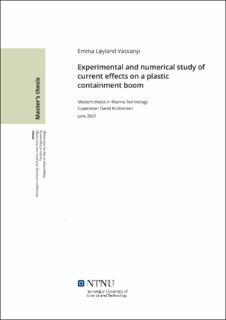| dc.contributor.advisor | Kristiansen, David | |
| dc.contributor.author | Vassanyi, Emma Løyland | |
| dc.date.accessioned | 2021-09-25T16:41:46Z | |
| dc.date.available | 2021-09-25T16:41:46Z | |
| dc.date.issued | 2021 | |
| dc.identifier | no.ntnu:inspera:78668897:25569939 | |
| dc.identifier.uri | https://hdl.handle.net/11250/2783350 | |
| dc.description.abstract | Denne masteroppgava er en numerisk og eksperimentell studie gjennomført for å studere de hydrodynamiske effektene på lenser for oppsamling av plast fra havet. To-dimensjonale laboratorietester ble gjennomført for å analysere et konvensjonelt lensedesign med en ubøyelig modell. Denne var sylinderforma, hadde en lengde på 0.561 m, og ble taua ved strømningshastighetene 0.1-0.5 m/s. Ei ubøyelig plate ble festa perpendikulært under sylinderen, for å opptre som ei lenses skjerm. For noen av testene var ei not festa til bunnen av skjermen. Testene ble gjennomført for ulike vinklinger av skjermen i forhold til den vertikale aksen, slik at ulike deformasjoner av skjermen ble simulert. Vinklene som ble testa var i området -60 grader til 60 grader for modellen uten not, og -45 grader til 45 grader for modelltester med not. Minustegnet indikerer rotasjon mot klokka og mot taueretninga. I de numeriske simuleringene var skjermen vertikal for alle simuleringene, og ble testa for de samme hastighetene i modellskala som i eksperimentene. Analytiske utregninger ble også gjennomført, for å sammenlikne de numeriske og eksperimentelle resultatene med teori. Resultatene viste at drag koeffisienten var omtrent konstant over de ulike vinklene for modellen uten not, mens den sank i verdi for økende hastighet for modellen med not. Noen av verdiene passerte 2, og for modellen med not passerte nesten alle verdiene 2. Ved sammenlikning med teoretisk drag koeffisient og tidligere målte drag koeffisienter viste at modelltestene uten not ikke var tilstrekkelige. De numeriske drag koeffisientene var derimot mye nærmere de teoretiske. Strømningskreftene i fullskala passerte også kreftene målt av The Ocean Cleanup (Brambini et al. 2017). Deres målte kraft ved høy fortøyning av lensa ved 0.5 m/s var 34% av krafta målt ved eksperimentene, mens for den lave fortøyninga var The Ocean Cleanup sin kraft 23% av krafta fra eksperimentene. Ved 0.3 m/s var krafta for begge fortøyningene 60% av den eksperimentelle. Visualisering av eksperimentene viste at nota kunne øke effektiviteten til lensa. | |
| dc.description.abstract | This master thesis is a numerical and experimental study conducted to investigate the hydrodynamic effects of containment booms for collection of plastic in open oceans. Two-dimensional experimental laboratory tests and numerical simulations in OpenFOAM were conducted to analyse a conventional boom design. The experimental tests were conducted with a 0.561 meters long, rigid, circular cylindrical model, that was towed in a tank to simulate currents in the range 0.1-0.5 m/s (Reynolds number range 20 000-100 000). A rigid plate was fastened perpendicular to the cylinder to act as the screen below the boom. The angle of the screen could be changed to simulate different deformations of the screen. For some of the tests a net was attached to the bottom of the screen. The tested angles with respect to the vertical axis were in the range-60◦to 60◦, and -45◦to 45◦for the tests with net. The minus indicates rotation counterclockwise towards the towing direction. In the numerical simulations, the screen was only kept vertical, and was tested for the same model scale velocities as the experiments. Analytical calculations were also conducted to compare the numerical and experimental results with theory. The results showed that for the model without net the drag coefficient was approximately constant for each of the angles over the different velocities, while for the model with net it was decreasing for increasing velocity. Some of the values exceeded 2, and for the tests with net almost all of the values exceeded 2. Comparison with theoretical drag coefficient, and previously measured drag coefficients also showed that the obtained drag coefficients for model tests without net were not entirely satisfactory. However, the numerical drag coefficients were significantly closer to the theoretical values. The full scale forces exceeded the forces measured by The Ocean Cleanup (Brambini et al. 2017) as well. Their force from high mooring at 0.5 m/s was 34% of the force from the physical experiments, while for the low mooring case at 0.5 m/s it was 23% of the force from the physical experiments. Both mooring cases at 0.3 m/s were 60% of the force from the physical experiments. A visualisation of the flow showed that the net could increase the capturing efficiency for model scale velocities up to 0.4 m/s. | |
| dc.language | eng | |
| dc.publisher | NTNU | |
| dc.title | Experimental and numerical study of current effects on a plastic containment boom | |
| dc.type | Master thesis | |
